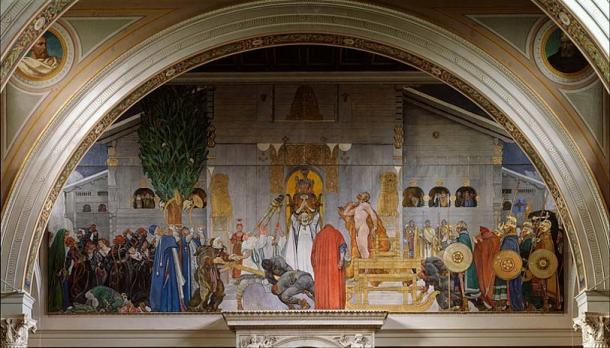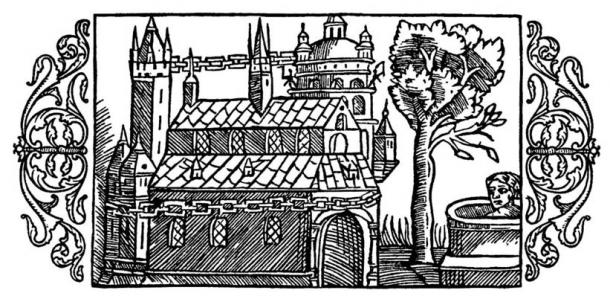
The Heathen Hof: Resurrecting a Germanic Pagan Temple
A heathen hof, also referred to as a Germanic pagan temple, is the name given to a place of worship in the Germanic religion. These were pre-Christian temples found in various parts of Northern Europe, where Germanic paganism thrived. Such places of worship have been mentioned by various medieval writers, and some have even been preserved in the archaeological record. These sources of information allow us to have a unique glimpse into the world of the pagan Germanic belief system.
What’s a ‘Hof’?
The word ‘hof’ is said to have originally been used to denote a hall, after which it was also used to designate a court, and even a farm. It was only later on that it acquired its religious association as a place of worship. There are different opinions amongst scholars regarding the way these hofs functioned. Some, for example, argue that hofs were used exclusively for rituals, whilst others have suggested that they did not only serve a religious purpose, but were used also for feasting and dwelling.
Animal Sacrifice and Feasting
Heathen hofs, along with some of their associated rituals, have been mentioned in a number of medieval sources. For example, in Hakon the Good’s Saga, which is found in Snorri Sturluson’s Heimskringla, there is a description of a sacrifice festival being carried out at Hlader. The sacrifices involved the slaughtering of all kinds of cattle, as well as horses. The blood of these sacrificed animals was then collected, and sprinkled over the altars, the interior and exterior temple walls, and the people gathered there. The meat of these animals was then boiled and given those attending the sacrifice.
- Return of the Ancient Gods: The Resurgence of Paganism
- Song of the Nibelungs: The Epic Germanic Tale of Love, Death, and Revenge
- Futhark: Mysterious Ancient Runic Alphabet of Northern Europe

‘Midvinterblot’ (1915) by Carl Larsson: King Domalde offers himself for sacrifice before the hof at Gamla Uppsala. (Public Domain)
Archaeological evidence has been used in the past to lend support to the textual references of ritual sacrifice and feasting such as that found in Sturluson’s writing. As an example, at the Viking Age site of Hofstaðir, in Iceland, archaeologists have recovered at least 23 cattle skulls which had been deposited at the southern end of a large hall-like building. Initially, the monumental size of the structure, the discovery of the faunal remains as well as the name of the site, all suggested this building had been used for cult purposes. Later on, however, this interpretation was challenged, as scholars noticed the similarities between this structure and other farmsteads, with size being the only difference.

Aerial shot of Hofstaðir. (germanicmythology)
Hofs in England and Sweden
Another site where the discovery of large quantities of animal bones was associated with the remains of a hof is Yeavering, in England. This interpretation is supported by the presence of a cemetery that grew around the structure.
Another site mentioned by the literature as having a hof is Gamla Uppsala, in Sweden. This is a well-known Viking Age site, and its pagan temple was mentioned by Adam of Bremen, a medieval chronicler from Germany. According to the writer, the hof at Gamla Uppsala was completely decked out in gold, and three deities – Thor, Wotan, and Frikko, were worshipped there. In addition, priests were appointed for each of the gods, who would offer sacrifices to them on behalf of the people. Adam of Bremen also describes a large feast held at the site once every nine years. According to the writer, one of the ceremonies was the sacrifice of various male living things, including human beings. The bodies of these victims were hung in a sacred grove beside the temple.
- On the Origins of the Runes - Symbols, Mysteries and Magico-religious Concepts
- Nachzehrers: The Shroud Eating Vampires of Germanic Folklore
- The Exceptional Story of the Kovel Spearhead, Who Made it and Where is it Today?

A woodcut depicting the Temple of Uppsala, as described by Adam of Bremen. (Public Domain)
After Centuries, a New Hof Emerges
With the coming of Christianity, the Germanic religion lost its place in society. The hofs lost their importance as a result of this conversion too. The Venerable Bede, for example, wrote about the conversion to Christianity of Edwin, the king of Northumbria. His high priest, Coifi also embraced the new faith, and volunteered to destroy the temple and the idols he had once worshiped. Bede mentions that this temple was located at a site called Godmundinghan, which is not far from York.
Whilst Christianity eventually triumphed over the Germanic religion, there are some today who have sought to revive it. One of these neo-pagan groups is the Asatru. In 2015, the Icelandic group made history, as it began the construction of their hof, the first in a Nordic country in over a thousand years. Whilst it is unlikely that the hof will be used for ritual sacrifices, it could serve as a place for other communal ceremonies, including feasts, marriages, and funerals.
Video link: https://www.youtube.com/watch?v=hwB_3QMgYRI
Top image: Artist's rendering of the hof, a pagan temple, in Uppsala, Sweden. Source: germanicmythology
By: Wu Mingren
References
Bede, Ecclesiastical History of the English Nation, Book II [Online]
[Jane, L.C. (trans.), 1910. Bede’s Ecclesiastical History of the English Nation, Book II.]
Available at: https://sourcebooks.fordham.edu/Halsall/basis/bede-book2.asp
McMahon, N., 2015. Iceland's Asatru pagans reach new height with first temple. [Online]
Available at: http://www.bbc.com/news/world-europe-31437973
Snorri Sturluson, Heimskringla [Online]
[Laing, S. (trans.), 1844. Sturluson’s Heimskringla.]
Available at: http://omacl.org/Heimskringla/
www.germanicmythology.com, 2010. The Heathen Hof at Hofstaðir, Iceland. [Online]
Available at: http://www.germanicmythology.com/original/HofstadirHof.html
www.germanicmythology.com, 2010. The Temple at Old Uppsala and the Royal Burial Mounds. [Online]
Available at: http://www.germanicmythology.com/works/uppsalatemple.html
www.pastperfect.org.uk, 2017. Yeavering Saxon Royal Palace: The temple and associated buildings. [Online]
Available at: http://www.pastperfect.org.uk/sites/yeavering/archive/1808.html















